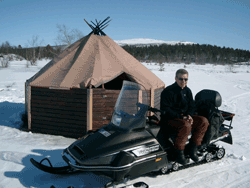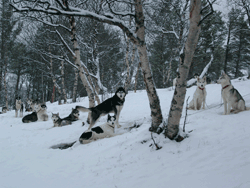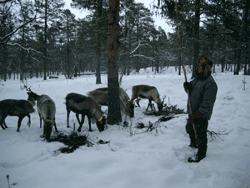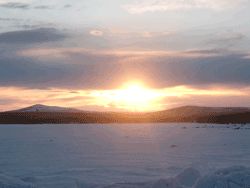There are many types of activities available during the winter. Snowshoes, Ice climbing, Snowmobile, dog sledge, Skiing, Snowboarding and Kite boarding or glacier walks to name some of the main outdoor sports that can be done by individuals or a selected group.
These sports can be done in a very controlled environment but for many individuals with a certain experience level the adrenalin level is raised by leaving the controlled environment and go out into the wilderness.

There are companies offering champagne tours to the North Pole and are calling it an adventure. No adventurer will consider this real, and this is certainly not the stuff to be taken seriously. I am talking about the real stuff. This stuff includes the journey through wilderness. If you would like exactly that, if your hands start sweating and your heart starts beating at an uncontrollable rate not much different than on your first date, then you have the heart for adventures.
Here are some important guidelines for you:
You should gain the knowledge and know-how in order to survive in the wilderness. Knowledge and education can be obtained in special schools. Educate yourself. Practice in bad conditions...for example the local freezer etc. Once you have got the practice and think you now possess the know-how, then don't flatter yourself - you definitely don't. Go home and learn some more!.....
Naturally you have taken part in a real avalanche class and possibly a survival class, not one of those "Yuppie kill the chicken and feel free" weekend therapy sessions. You have learned your first aid course. You have learned everything there is to know. You know your card and your area well enough to know where and how to seek shelter.

If you are living in the city, help out in the local meat market, they have large freezers, get used to the cold! The long walks you might take in your local park in the heavy rain or perhaps even in minus degrees is nothing close to going out into the real wilderness such as Sarek or Padjelante, Europe's oldest national park and world treasure. This is one of the places you might run into me.
You have learned everything there is to know about clothes, ventilating systems and the dressing in layers. I have seen many people that had to borrow clothes from me since they were dressed in clothes that had been the inn product within city limits, but did not stand what they promised. I am sure that you are the person that would only buy a product from a company that actually has test pilots testing their equipment. I take such products out by -40 cel. and I test and use them professionally. So trust me, to really be sure that the company that sells the products also satisfies your quality needs, make sure they have a person who has actually tested their products in real life. It is your life that depends on it.
It is nice to carry around a GPS and a receiver-transmitter. The other day I heard a story from a friend of mine, a rescuer, about a guy who took his whole family out into the wilderness, they got lost and were

running around for two days until they where found. Cell phones did not have coverage in this area. The good man had a GPS with him. He knew how to turn on the power button; he did not know how to operate it. They where lucky enough and did get rescued, but some are not so lucky. I will not bore you with statistics since I presume that you also think that one death is as horrible as a hundred. When I take someone out with me my first question is - "Can you read the compass"? Out of 20 people that go out 4 actually can really read the compass.
If you are out practicing, go out for the first time with a guide that knows the area. The guide will have valuable tips and tricks for you, and it is actuallyt worth to pay attention. And after all you are paying the guide. Get something out of it, a guide is more than a helping hand a guide carries wisdom!!...In the cold you have to keep warm, trust me, the winds are a factor that you can't underestimate and a blizzard can come out of nowhere.
Here is something for practice to get you on the right track. Have something warm to drink, something sweet, some chocolate bars. No matter how short your tour is - it requires a compass and a sleeping bag. Tell people where you are going, tell them about optional routes you might be taking if the weather turns. Make sure people expect you to arrive. They might be the ones that have to look for you. If they don't know how to keep from freezing - have extra clothing, wear loose layers of clothing. Your vital organs should be protected more than just casual, they keep your blood flowing. Always have a alternative for everything, you have your ski along good take your snowshoes as well!
The more you practice the more confident you get. You learn to react instead of panic. Panic is not part of a difficult situation, and trust me, I can set you out in places where the toughest person will panic, without the necessary training!! Coincidently, someone who has trained in the extreme will react much calmer in everyday situations, because you train motion, psychological, physical and tactical.
If you think the sunglasses I am wearing are cool, think again, they have a purpose. Everything in the xtreme has a purpose. Nobody wears or carries a brand name because they are in, hip or down with the crowd. Whatever the soap opera generation might call it. I and my friends wear and carry them because they have to be the best, otherwise I don't!
In the soap operas you will learn that backstabbing is good and tearing someone down might win you the million and fame. In the outdoors and outbacks you will learn different values, no money to be won when you are spending time with someone else outside. If you go together with someone, cheer the other person up, be a positive person, choose also a same minded person as a partner. Let the weather decide the pace distance of your course. Leave messages for people who expect you to arrive and people that know when you departed. Try to stay on paths

that are marked in your map as well as marked outside. Do not pack too heavy. It is important to pack the right stuff, when you are resting, it is important to stay warm, wind and rain resisting clothing is a must. I always carry extra gloves with me. Include a compass; a GPS may not work, due to coldness or battery failure. Know the equipment you are using! Don't underestimate the weather. Stay tuned with weather reports in the local area, use weather services that work on your GSM. Even if you can read weather, it might change from one minute to the next. Seek shelter or make shelter before the weather hits you. Only an idiot stands against the weather!
If you think something is too risky then it is good to be coward, and not do the daring thing. Be extra careful when it comes to ice. In some areas it is still safe to be out in March, April or sometimes even in May, but in many places it is not safe anymore.
Know avalanches
Avalanches occur when you have terrain that elevates more than 25%. A simple trick to use is your ski poles. Place one up-right (vertical) onto the elevated area. Your partner takes the second stick. The stick is placed horizontal with the tip of the ski on the ground and the end touching the vertical one. If the horizontal pole touching the ski pole in the middle then you have reached about a 25.o. If it touches the vertical stick on the top you have a 45 degree ascent.

If there is a large density of snow collected in the end area, avoid it, it might brake off. If the snow cover is under much pressure or if the heavy snow cover is on top of a loose cover, a avalanche might brake. Heavy snow, hard wind, snow weather with dry snow on top of heavy snow, a decent rainfall, fast temperature changes to +celcious.
You should always have a Transceiver, plenty of reflectors on your clothing. A shovel and a foldable avalanche sond should be part of your equipment if you are heading into a area that could be risky. I myself try to avoid large openings and stick to places like the spine of a mountain when I go up. The scale of avalanche risk is one to five. If you are interested in the topic I suggest either "Staying alive in Avalanche terrain" by Bruce Temper and a kamasutra of snow "Secrets of the snow - Visual Clues to Avalanche and ski conditions".
Here is a intresting link in swedish http://www.utfard.nu/utfard1/uf1_link.shtml
So study and prepare yourself for the course ahead.
Stay safe //oliver
Extreme adventurer
These sports can be done in a very controlled environment but for many individuals with a certain experience level the adrenalin level is raised by leaving the controlled environment and go out into the wilderness.

There are companies offering champagne tours to the North Pole and are calling it an adventure. No adventurer will consider this real, and this is certainly not the stuff to be taken seriously. I am talking about the real stuff. This stuff includes the journey through wilderness. If you would like exactly that, if your hands start sweating and your heart starts beating at an uncontrollable rate not much different than on your first date, then you have the heart for adventures.
Here are some important guidelines for you:
You should gain the knowledge and know-how in order to survive in the wilderness. Knowledge and education can be obtained in special schools. Educate yourself. Practice in bad conditions...for example the local freezer etc. Once you have got the practice and think you now possess the know-how, then don't flatter yourself - you definitely don't. Go home and learn some more!.....
Naturally you have taken part in a real avalanche class and possibly a survival class, not one of those "Yuppie kill the chicken and feel free" weekend therapy sessions. You have learned your first aid course. You have learned everything there is to know. You know your card and your area well enough to know where and how to seek shelter.

If you are living in the city, help out in the local meat market, they have large freezers, get used to the cold! The long walks you might take in your local park in the heavy rain or perhaps even in minus degrees is nothing close to going out into the real wilderness such as Sarek or Padjelante, Europe's oldest national park and world treasure. This is one of the places you might run into me.
You have learned everything there is to know about clothes, ventilating systems and the dressing in layers. I have seen many people that had to borrow clothes from me since they were dressed in clothes that had been the inn product within city limits, but did not stand what they promised. I am sure that you are the person that would only buy a product from a company that actually has test pilots testing their equipment. I take such products out by -40 cel. and I test and use them professionally. So trust me, to really be sure that the company that sells the products also satisfies your quality needs, make sure they have a person who has actually tested their products in real life. It is your life that depends on it.
It is nice to carry around a GPS and a receiver-transmitter. The other day I heard a story from a friend of mine, a rescuer, about a guy who took his whole family out into the wilderness, they got lost and were

running around for two days until they where found. Cell phones did not have coverage in this area. The good man had a GPS with him. He knew how to turn on the power button; he did not know how to operate it. They where lucky enough and did get rescued, but some are not so lucky. I will not bore you with statistics since I presume that you also think that one death is as horrible as a hundred. When I take someone out with me my first question is - "Can you read the compass"? Out of 20 people that go out 4 actually can really read the compass.
If you are out practicing, go out for the first time with a guide that knows the area. The guide will have valuable tips and tricks for you, and it is actuallyt worth to pay attention. And after all you are paying the guide. Get something out of it, a guide is more than a helping hand a guide carries wisdom!!...In the cold you have to keep warm, trust me, the winds are a factor that you can't underestimate and a blizzard can come out of nowhere.
Here is something for practice to get you on the right track. Have something warm to drink, something sweet, some chocolate bars. No matter how short your tour is - it requires a compass and a sleeping bag. Tell people where you are going, tell them about optional routes you might be taking if the weather turns. Make sure people expect you to arrive. They might be the ones that have to look for you. If they don't know how to keep from freezing - have extra clothing, wear loose layers of clothing. Your vital organs should be protected more than just casual, they keep your blood flowing. Always have a alternative for everything, you have your ski along good take your snowshoes as well!
The more you practice the more confident you get. You learn to react instead of panic. Panic is not part of a difficult situation, and trust me, I can set you out in places where the toughest person will panic, without the necessary training!! Coincidently, someone who has trained in the extreme will react much calmer in everyday situations, because you train motion, psychological, physical and tactical.
If you think the sunglasses I am wearing are cool, think again, they have a purpose. Everything in the xtreme has a purpose. Nobody wears or carries a brand name because they are in, hip or down with the crowd. Whatever the soap opera generation might call it. I and my friends wear and carry them because they have to be the best, otherwise I don't!
In the soap operas you will learn that backstabbing is good and tearing someone down might win you the million and fame. In the outdoors and outbacks you will learn different values, no money to be won when you are spending time with someone else outside. If you go together with someone, cheer the other person up, be a positive person, choose also a same minded person as a partner. Let the weather decide the pace distance of your course. Leave messages for people who expect you to arrive and people that know when you departed. Try to stay on paths

that are marked in your map as well as marked outside. Do not pack too heavy. It is important to pack the right stuff, when you are resting, it is important to stay warm, wind and rain resisting clothing is a must. I always carry extra gloves with me. Include a compass; a GPS may not work, due to coldness or battery failure. Know the equipment you are using! Don't underestimate the weather. Stay tuned with weather reports in the local area, use weather services that work on your GSM. Even if you can read weather, it might change from one minute to the next. Seek shelter or make shelter before the weather hits you. Only an idiot stands against the weather!
If you think something is too risky then it is good to be coward, and not do the daring thing. Be extra careful when it comes to ice. In some areas it is still safe to be out in March, April or sometimes even in May, but in many places it is not safe anymore.
Know avalanches
Avalanches occur when you have terrain that elevates more than 25%. A simple trick to use is your ski poles. Place one up-right (vertical) onto the elevated area. Your partner takes the second stick. The stick is placed horizontal with the tip of the ski on the ground and the end touching the vertical one. If the horizontal pole touching the ski pole in the middle then you have reached about a 25.o. If it touches the vertical stick on the top you have a 45 degree ascent.

If there is a large density of snow collected in the end area, avoid it, it might brake off. If the snow cover is under much pressure or if the heavy snow cover is on top of a loose cover, a avalanche might brake. Heavy snow, hard wind, snow weather with dry snow on top of heavy snow, a decent rainfall, fast temperature changes to +celcious.
You should always have a Transceiver, plenty of reflectors on your clothing. A shovel and a foldable avalanche sond should be part of your equipment if you are heading into a area that could be risky. I myself try to avoid large openings and stick to places like the spine of a mountain when I go up. The scale of avalanche risk is one to five. If you are interested in the topic I suggest either "Staying alive in Avalanche terrain" by Bruce Temper and a kamasutra of snow "Secrets of the snow - Visual Clues to Avalanche and ski conditions".
Here is a intresting link in swedish http://www.utfard.nu/utfard1/uf1_link.shtml
So study and prepare yourself for the course ahead.
Stay safe //oliver
Extreme adventurer
|
|


